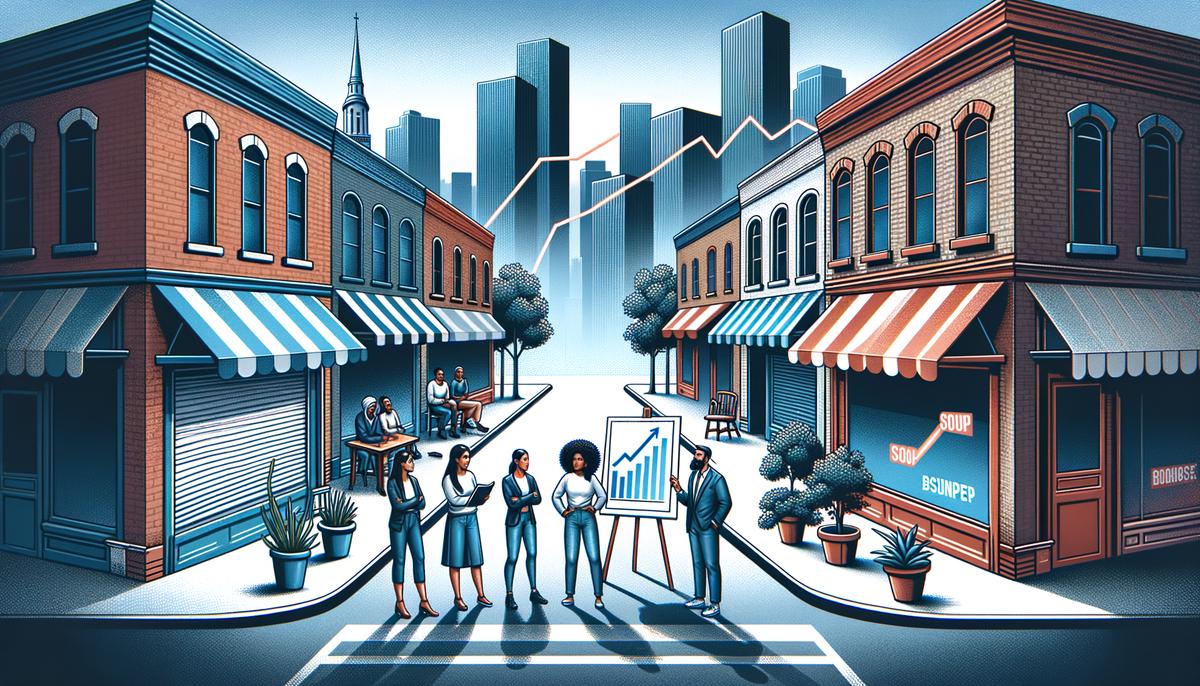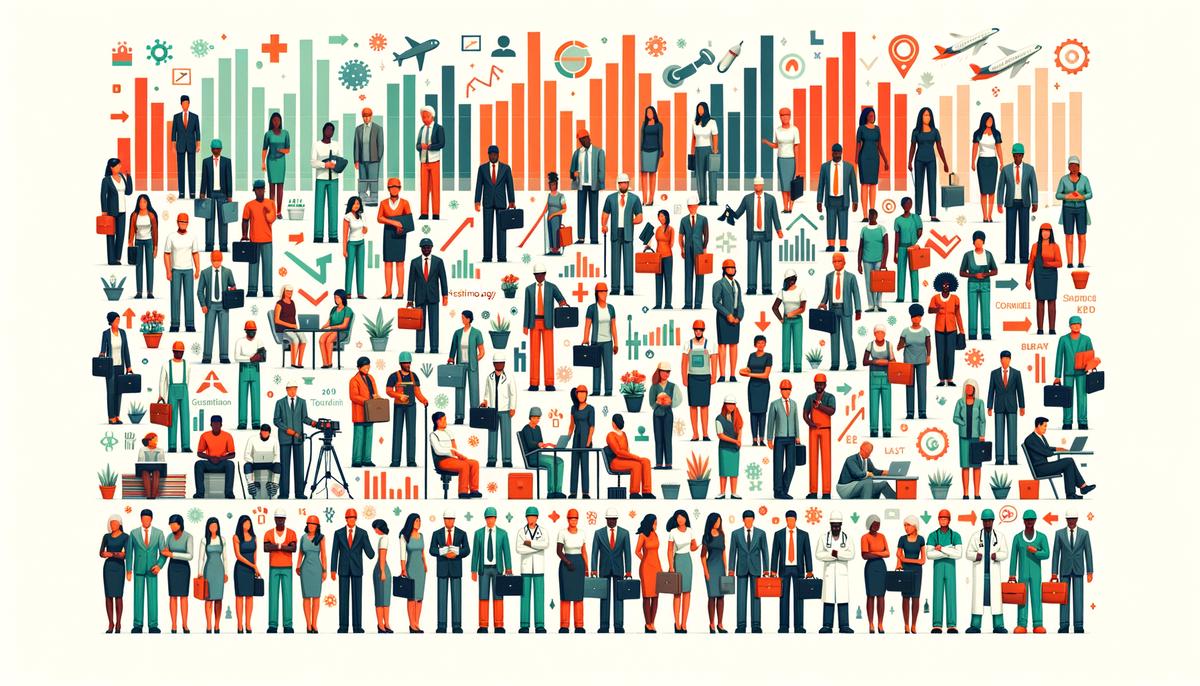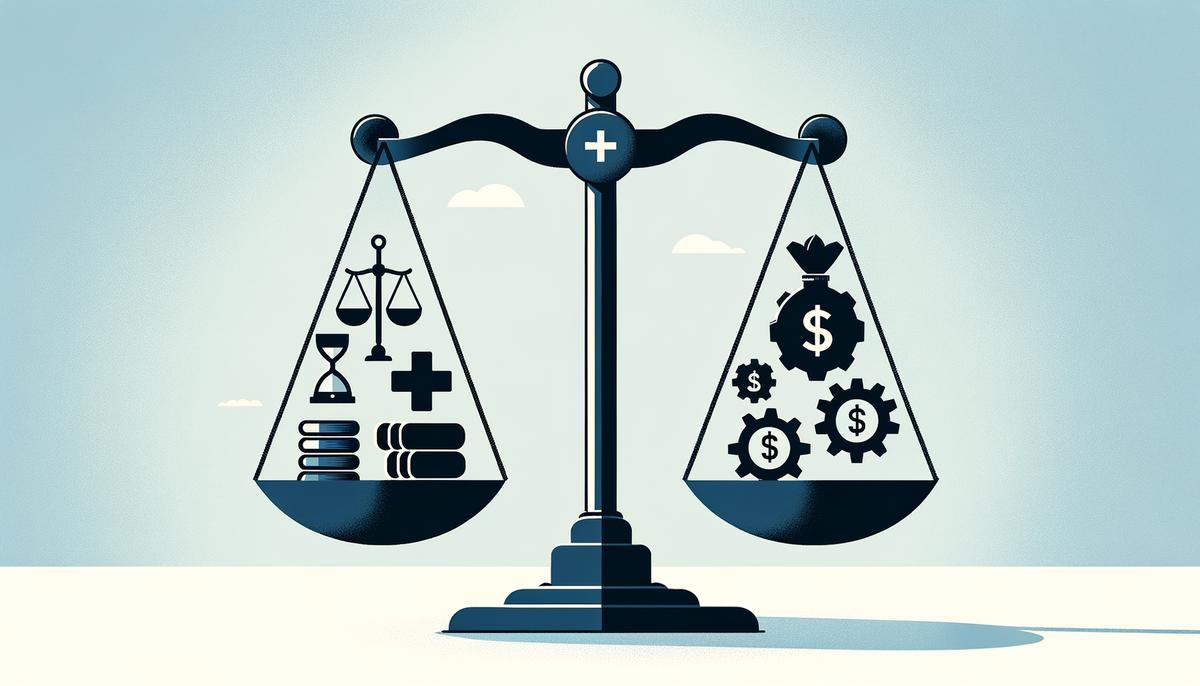Our Blog
Analysis of How the US Avoided the 2023 Recession
In 2023, the United States managed to navigate through uncertain economic waters and avoid a recession, a feat that captured the attention of economists and citizens alike. Understanding how the U.S. achieved this requires a look at several key strategies and decisions made throughout the year.
Stimulating the Economy Through Policy Measures
The government played a crucial role in preventing a recession by implementing effective policy measures. These included maintaining low interest rates for a significant part of the year, which encouraged borrowing and spending by businesses and consumers alike. Additionally, targeted fiscal policies, such as stimulus checks and tax incentives, helped to boost consumer spending and keep the economy active.
Adapting to the Pandemic’s Challenges
The ongoing challenges posed by the COVID-19 pandemic required swift adaptation and resilience. Businesses across the country embraced flexibility, with many shifting to online operations and remote work models. This not only helped companies stay afloat but also preserved jobs and kept the unemployment rate lower than many had predicted.
Investment in Infrastructure and Technology
Investments in infrastructure and technology also played a pivotal role. The push towards modernizing America’s infrastructure meant launching projects that created jobs and stimulated economic growth. Meanwhile, advancements in technology and the rise of digital services opened new markets and opportunities for growth, ensuring that various sectors of the economy could continue to expand.
The Role of Consumer Confidence and Spending
Consumer confidence remained surprisingly robust in 2023. Many Americans, feeling optimistic about the future, continued to spend on goods and services. This sustained demand was critical in keeping businesses running and preventing the widespread downturn that typically defines a recession.
A Coordinated Global Response
It’s important to note that the U.S. didn’t navigate these challenges in isolation. A coordinated global response to economic threats, including partnerships and agreements with other nations, helped stabilize the global economy. This international collaboration ensured that trade remained steady and markets were less volatile.
Conclusion
Avoiding a recession in 2023 was a testament to the resilience and adaptability of the U.S. economy. Through strategic policy decisions, adapting to the pandemic, investing in the future, maintaining consumer confidence, and cooperating on a global scale, the United States managed to keep its economy moving forward even in the face of numerous challenges. This collective effort underscored the importance of proactive planning and flexibility in economic management.

The Economic Outlook for 2024
Navigating Job Market Trends and Shifting Industries
As we peer into the economic outlook for 2024, a pivotal factor shaping the landscape is the transformation within the job market and industry sectors. The evolution of industries, escalated by rapid technological advancements and the residual effects of the pandemic, presents both challenges and opportunities for employment and economic growth.
Technological Innovations Reshaping Employment
The surge in automation and artificial intelligence (AI) is not merely a subplot in the story of the future economy; it’s a key protagonist. These innovations are streamlining operations across manufacturing, finance, and even the creative sectors, enhancing efficiency but also displacing certain jobs. However, alongside these shifts, new roles are emerging, particularly those requiring digital literacy and specialized skills in AI, cybersecurity, and data analysis. This evolution underscores the necessity for workforce upskilling and reskilling programs to equip individuals for the jobs of tomorrow.
Green Economy and Sustainable Practices Spur Growth
The drive towards sustainability and green practices is another influential trend shaping economic forecasts. As countries and corporations commit to reducing their carbon footprints, industries such as renewable energy, sustainable agriculture, and green construction are poised for significant expansion. This shift not only promises to create jobs but also stimulates investment in eco-friendly technologies and infrastructures, contributing to a more sustainable and resilient economy.
Demographic Changes and Consumer Behavior
Understanding demographic shifts is crucial when discussing the economic outlook for 2024. Aging populations in developed nations and youthful demographics in emerging markets are influencing consumer behavior and spending patterns. These changes demand adaptations from businesses in terms of products, services, and marketing strategies. Moreover, the growing emphasis on health, wellness, and ethical consumption is steering the economy towards sectors that can meet these evolving consumer preferences.
E-commerce and the Digital Marketplace
The unparalleled rise of e-commerce, accelerated by the COVID-19 pandemic, is expected to continue reshaping the retail landscape in 2024. The convenience, variety, and personalization offered by online shopping are setting new consumer expectations, compelling traditional retailers to innovate and integrate digital solutions. This trend is not limited to consumer goods; services such as online education, telehealth, and virtual consultations are becoming increasingly mainstream, marking a broader shift towards a digital-first economy.
Looking Ahead
As we approach 2024, the economic landscape is marked by significant uncertainty but also ripe with opportunities. The key to harnessing these opportunities lies in adaptability—both at the individual and organizational levels. Governments, businesses, and individuals must remain agile, open to learning, and ready to pivot strategies in response to the dynamic economic conditions. With the right approach, the challenges of today can become the growth stories of tomorrow, leading to a stronger, more resilient economy.

Impact on the Labor Market and Staffing
As we approach 2024, the employment landscape is poised to undergo significant transformations influenced by recent global developments and emerging trends. Understanding these shifts is essential for businesses and professionals aiming to stay ahead.
Flexibility and Remote Work: The New Normal
The traditional 9-to-5 office setup has been fundamentally challenged. With the successful adoption of remote work during the pandemic, many companies and employees have recognized the benefits of flexible working arrangements. In 2024, expect to see an increase in hybrid work models, where employees split their time between the office and remote locations. This flexibility can lead to higher job satisfaction and productivity, as people are better able to balance work and personal life.
Rise of the Gig Economy and Freelancing
Driven by the desire for flexibility and autonomy, more individuals are turning to freelancing and gig work. Companies are also leveraging this trend, hiring freelancers and contractors to tackle projects, fill gaps in their workforce, and access specialized skills without the commitment of a full-time employee. This shift not only changes how work is done but also how companies and freelancers approach job security and benefits.
Upskilling and Continuous Learning
As technology evolves at an unprecedented rate, the demand for new skills is soaring. Both employers and employees need to commit to continuous learning and upskilling to remain competitive. In 2024, expect to see companies investing more in training programs and employees seeking out learning opportunities to keep up with industry changes. This focus on education is crucial for filling the skills gap, especially in fast-growing fields like technology, healthcare, and renewable energy.
Emphasis on Mental Health and Well-being
Awareness of the importance of mental health has grown, and companies are taking note. In 2024, expect mental health support and well-being initiatives to become standard components of employment packages. Businesses that prioritize the mental and physical health of their employees can improve retention, reduce absenteeism, and boost overall productivity.
- Adapting to Demographic Shifts
The workforce is becoming more diverse and inclusive, reflecting broader demographic changes. Companies are making concerted efforts to create inclusive environments that attract and retain talent from all backgrounds. This includes addressing gender disparities, supporting older workers, and enhancing diversity and inclusion initiatives.
Automation and AI: Redefining Roles
Automation and artificial intelligence (AI) continue to reshape the job market, automating routine tasks and creating new roles that require human-machine collaboration. While some jobs may be displaced, new opportunities are emerging in AI management, data analysis, and tech support. Companies and workers alike must adapt to these changes, embracing new technologies and focusing on the human skills that machines cannot replicate.
In conclusion, the employment and staffing trends for 2024 reflect a dynamic, changing landscape shaped by technological advancements, changing work preferences, and a renewed focus on well-being and continuous learning. As we move forward, flexibility, adaptability, and a commitment to personal development will be key to thriving in this new era.

Strategies for Businesses to Navigate 2024
To ensure that businesses thrive in 2024, it’s paramount that they not only acknowledge but actively incorporate several strategic approaches in their operational, HR, and marketing endeavors.
**Embracing Diversity and Inclusion**:
In today’s progressively global environment, creating a diverse and inclusive workplace is not just ethical but is becoming a cornerstone for innovative and competitive businesses. By ensuring that your team represents a variety of backgrounds, skills, and perspectives, you’re not only enhancing creativity but also improving problem-solving within the company. More importantly, a diversified environment attracts a broader customer base by reflecting the varied society we live in, thereby boosting consumer relations and market share.
**Enhanced Customer Experience and Personalization**:
In an age where the customer has endless choices at their fingertips, personalizing the customer experience is crucial. Leveraging data analytics to understand customer preferences and behaviors can enable businesses to tailor their products, services, and marketing messages to meet the specific needs and interests of their target audience. This approach not only increases customer satisfaction but also fosters loyalty, which is essential in a highly competitive market.
**Strategic Partnerships and Collaboration**:
No business is an island, and in 2024, the importance of forging strategic partnerships cannot be overstated. Collaboration allows businesses to share resources, knowledge, and markets, thus facilitating innovation and expansion into new territories. Whether it’s a tech company partnering with an environmental organization to promote sustainable practices or a fashion brand collaborating with influencers for wider market reach, strategic partnerships can provide a win-win scenario for growth and sustainability.
**Proactivity Towards Cybersecurity**:
As businesses continue to digitize operations and increase their online presence, the risk of cyber threats also escalates. Investing in robust cybersecurity measures is essential to protect sensitive information and maintain customer trust. Proactive cybersecurity strategies, including regular audits, employee training, and the adoption of cutting-edge security technologies, can safeguard businesses from potential cyberattacks, ensuring operational integrity and continuity.
**Sustainability and Social Responsibility**:
Consumers are increasingly favoring companies that demonstrate a commitment to sustainability and social responsibility. By integrating green practices into operations, businesses not only contribute to the planet’s welfare but also align with the values of eco-conscious consumers. Moreover, engaging in community-oriented projects and supporting social causes can enhance a company’s image, foster employee pride, and attract customers who prioritize ethical consumption.
**Market Adaptability**:
The ability to swiftly adapt to market changes and consumer trends is more critical than ever. Staying attuned to the economic environment, technological advancements, and societal shifts allows businesses to anticipate changes and adjust their strategies accordingly. Flexibility in product development, marketing strategies, and business models is key to staying relevant and competitive in a constantly evolving landscape.
In conclusion, as we look towards 2024, businesses must be agile, innovative, and forward-thinking in their strategies. By focusing on diversity and inclusion, enhancing customer experience, fostering strategic partnerships, prioritizing cybersecurity, committing to sustainability, and maintaining adaptability, companies can position themselves for success in an uncertain future. Each of these strategies not only addresses immediate business needs but also sets the stage for long-term growth and resilience.

The Role of Government Policy in Shaping 2024
Government policy plays a crucial role in shaping the economy, especially as we look ahead to 2024. The decisions made by policymakers have a direct influence on economic growth, employment rates, and overall financial health for individuals and businesses alike. In this in-depth exploration, we’ll dive into how upcoming government policies are poised to impact the 2024 economy across various sectors, highlighting the potential shifts and developments that could emerge from these influences.
Fiscal Policy and Taxation Adjustments
One of the primary tools at the government’s disposal is fiscal policy, which includes adjustments to government spending and taxation. In 2024, changes in these areas could significantly stimulate economic activity or, conversely, slow it down. For instance, increased government spending on public services and infrastructure can create jobs and boost demand within the economy. Similarly, tax relief for individuals and small businesses can increase disposable income, encouraging spending and investment. Conversely, raising taxes to curb inflation might temporarily slow economic growth but could stabilize prices in the long run.
Monetary Policy and Interest Rates
Another key area of government influence involves monetary policy, primarily managed by the Federal Reserve in the United States. The Fed’s decisions on interest rates can profoundly impact borrowing costs for consumers and businesses. If the Fed opts to lower interest rates in 2024, it could encourage borrowing and investing, given the cheaper credit. This could, in turn, stimulate economic growth. However, if inflation becomes a concern, the Fed might raise interest rates to curb spending and borrowing, which could slow economic growth.
Healthcare Policy
Healthcare remains a significant portion of the U.S. economy, and government policies in this sector can have wide-reaching effects. With ongoing debates around healthcare reform, policies that expand access to healthcare or reduce costs could influence economic performance. For example, more affordable healthcare could increase disposable income for many Americans, potentially boosting consumer spending. Additionally, healthier populations are more productive, which can positively impact overall economic growth.
Environmental Regulations and Green Initiatives
As climate change concerns grow, government policies aimed at promoting sustainability and reducing carbon emissions are expected to increase. These might include incentives for renewable energy use, regulations limiting pollution from industries, and investments in green technologies. Such policies not only address environmental issues but can also spur economic growth by creating new industries and jobs. Moreover, they can encourage innovation as businesses seek to comply with new standards and take advantage of government incentives.
Trade Policies and International Relations
Trade policies play a significant role in shaping the economy by dictating the terms of international commerce. Changes in tariffs, trade agreements, or relations with key trading partners can substantially impact various sectors of the economy. For instance, reducing tariffs on imported goods might lower costs for consumers and businesses but could also challenge domestic producers facing increased competition. Conversely, fostering better trade relations can open up new markets for American goods and services, potentially boosting economic growth.
Conclusion
The influence of government policy on the 2024 economy cannot be understated. From fiscal and monetary policies to healthcare, environmental regulations, and trade agreements, the decisions made by policymakers will have a direct impact on the direction of economic growth. While these policies aim to stimulate the economy, create jobs, and ensure sustainable growth, their effectiveness will depend on a range of factors, including global economic conditions, technological advancements, and demographic trends. As we move closer to 2024, it will be essential to monitor these developments closely to understand their potential implications for the economy.

